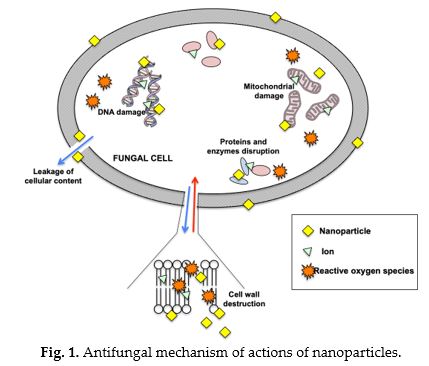Mini Review: Biologically Synthesized Nanoparticles as Antifungal Agents
DOI:
https://doi.org/10.37934/jrnn.1.1.2229Keywords:
Biological synthesis, nanoparticles, antifungal, drug resistanceAbstract
Fungal infections are affecting millions of people in the world every year. Severity of infections range from superficial mycoses to more chronic systemic mycoses. As more fungi species evolve, emergence of drug resistant strains is becoming a serious concern to the public health. There is now less number of effective antifungal drugs available in the market for treatment of invasive fungal infections. In an effort to combat this escalating issue, the use of nanoparticles as antifungal agent has been proposed and explored. Versatility of nanoparticles and its unique physico-chemical properties are proven beneficial for developing new therapeutic methods in treatment of fungal infections. Nanoparticles produced from biological synthesis have attracted keen interests from researchers, as they are more environmentally friendly, sustainable, cost-effective, and biocompatible. This mini review will provide an insight on the current antifungal studies and discuss the theory behind mechanism of actions of nanoparticles.
Downloads
References
J. Cardoso; D. G. Nakayama. Marine-Derived Compounds and Prospects for Their Antifungal Application. Molecules. 2020, 25. doi.org/10.3390/molecules25245856.
S. Chinnappan; C. Le Yi; C. J. Chen; T. W. Hsia; Y. H. Qi. Recent Advances in Delivery of Antifungal Agents – A Review. J. Young Pharm. 2020, 12(3), pp. 193–196. doi.org/10.5530/jyp.2020.12.59.
F. Sousa; D. Ferreira; S. Reis. Current Insights on Antifungal Therapy?: Novel Nanotechnology Approaches for Drug Delivery Systems and New Drugs from Natural Sources. Pharmaceuticals. 2020, 13(248), pp. 1–30. doi.org/10.3390/ph13090248.
B. Kischkel; S. A. Rossi; S. R. S. Junior. Therapies and Vaccines Based on Nanoparticles for the Treatment of Systemic Fungal Infections. Front. Cell. Infect. Microbiol. 2020, 10(463). doi.org/10.3389/fcimb.2020.00463.
N. Vera-González; A. Shukla. Advances in Biomaterials for the Prevention and Disruption of Candida Biofilms. Front. Microbiol. 2020, 11. doi.org/10.3389/fmicb.2020.538602.
J. A. Hernández-díaz; J. J. O. Garza-garcía; A. Zamudio-ojeda; J. M. León-morales; J. C. López-velázquez; S. García-morales. Plant-mediated synthesis of nanoparticles and their antimicrobial activity against phytopathogens. Soc. Chem. Ind. 2020. doi.org/10.1002/jsfa.10767.
I. Elibe; M. Emeka; I. Nweze. The use of nanoparticles as alternative therapeutic agents against Candida infections?: an up ? to ? date overview and future perspectives. World J. Microbiol. Biotechnol. 2020, 36(163), pp. 1–20. doi.org/10.1007/s11274-020-02940-0.
M. Atif et al. Synthesis and characterization of titanium dioxide nanoparticles by chemical and green methods and their antifungal activities against wheat rust. Chemosphere. 2020, 258. doi.org/10.1016/j.chemosphere.2020.127352.
K. Seku et al. A rapid microwave ? assisted synthesis of silver nanoparticles using Ziziphus jujuba Mill fruit extract and their catalytic and antimicrobial properties. Chem. Pap. 2020. doi.org/ 10.1007/s11696-020-01386-w.
R. M. Alharbi; A. A. F. Soliman; A. A. Abd; E. Aty. Comparative Study On Biosynthesis of Valuable Antimicrobial and Antitumor Nano-silver Using Fresh Water Green and Blue-green Microalgae. J. Microbiol. Biotechnol. Food Sci. 2020, 2(10), pp. 249–256. doi.org/10.15414/jmbfs.2020.10.2.249-256.
A. A. Mohamed; M. Abu-elghait; N. E. Ahmed; S. S. Salem; S. S. Salem. Eco-friendly Mycogenic Synthesis of ZnO and CuO Nanoparticles for In Vitro Antibacterial , Antibiofilm , and Antifungal Applications. Biol. Trace Elem. Res. 2020. doi.org/10.1007/s12011-020-02369-4.
T. Dutta; N. Nath; M. Das; R. Adhikary; V. Mandal; A. P. Chattopadhyay. Synthesis of antibacterial and antifungal silver nanoparticles using Citrus limetta peel extract?: Experimental and theoretical studies. J. Environ. Chem. Eng., 2020, 8. doi.org/10.1016/j.jece.2020.104019.
G. Nikaeen; S. Yous; S. Rahmdel; F. Samari. Central Composite Design for Optimizing the Biosynthesis of Silver Nanoparticles using Plantago major Extract and Investigating Antibacterial , Antifungal and Antioxidant Activity. Sci. Rep. 2020, 10(9642), pp. 1–16. doi.org/ 10.1038/s41598-020-66357-3.
X. Jia; Y. Yao; G. Yu; L. Qu; T. Li; Z. Li. Synthesis of gold-silver nanoalloys under microwave-assisted irradiation by deposition of silver on gold nanoclusters / triple helix glucan and antifungal activity. Carbohydr. Polym. 2020, 238. doi.org/10.1016/j.carbpol.2020.116169.
S. Sebastiammal et al. Curcumin-encased hydroxyapatite nanoparticles as novel biomaterials for antimicrobial , antioxidant and anticancer applications?: A perspective of nano-based drug delivery. J. Drug Deliv. Sci. Technol. 2020, 57, p. 101752. doi.org/10.1016/j.jddst.2020.101752.
N. Y. Elmehbad; N. A. Mohamed. Designing , preparation and evaluation of the antimicrobial activity of biomaterials based on chitosan modified with silver nanoparticles. Int. J. Biol. Macromol. 2020, 151, pp. 92–103. doi.org/10.1016/j.ijbiomac.2020.01.298.
J. Iqbal et al. Biogenic synthesis of green and cost effective iron nanoparticles and evaluation of their potential biomedical properties. J. Mol. Struct. 2020, 1199, p. 126979. doi.org/10.1016/j.molstruc.2019.126979.
A. A. Yaqoob; H. Ahmad; T. Parveen; A. Ahmad; M. Oves. Recent Advances in Metal Decorated Nanomaterials and Their Various Biological Applications?: A Review. Front. Chem. 2020, 8. doi.org/10.3389/fchem.2020.00341.















